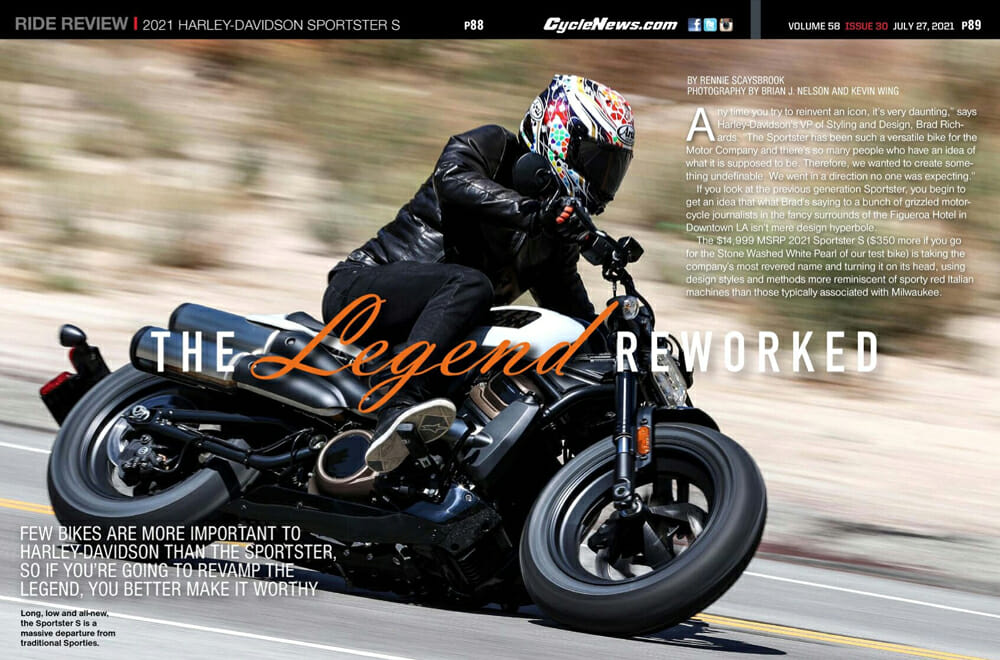Rennie Scaysbrook | July 31, 2021
Few bikes are more important to Harley-Davidson than the Sportster, so if you’re going to revamp the legend, you better make it worthy.
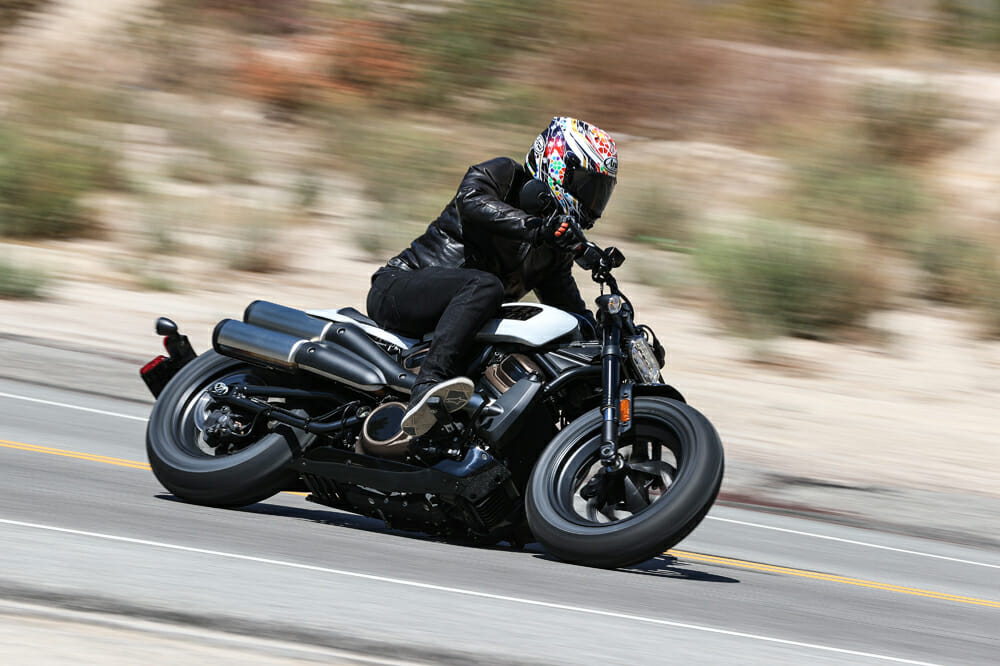 Long, low and all-new, the Sportster S is a massive departure from traditional Sporties.
Long, low and all-new, the Sportster S is a massive departure from traditional Sporties.
Photography by Brian J Nelson and Kevin Wing
Any time you try to reinvent an icon, it’s very daunting,” says Harley-Davidson’s VP of Styling and Design, Brad Richards. “The Sportster has been such a versatile bike for the Motor Company and there’s so many people who have an idea of what it is supposed to be. Therefore, we wanted to create something undefinable. We went in a direction no one was expecting.”
If you look at the previous generation Sportster, you begin to get an idea that what Brad’s saying to a bunch of grizzled motorcycle journalists in the fancy surrounds of the Figueroa Hotel in Downtown LA isn’t mere design hyperbole.
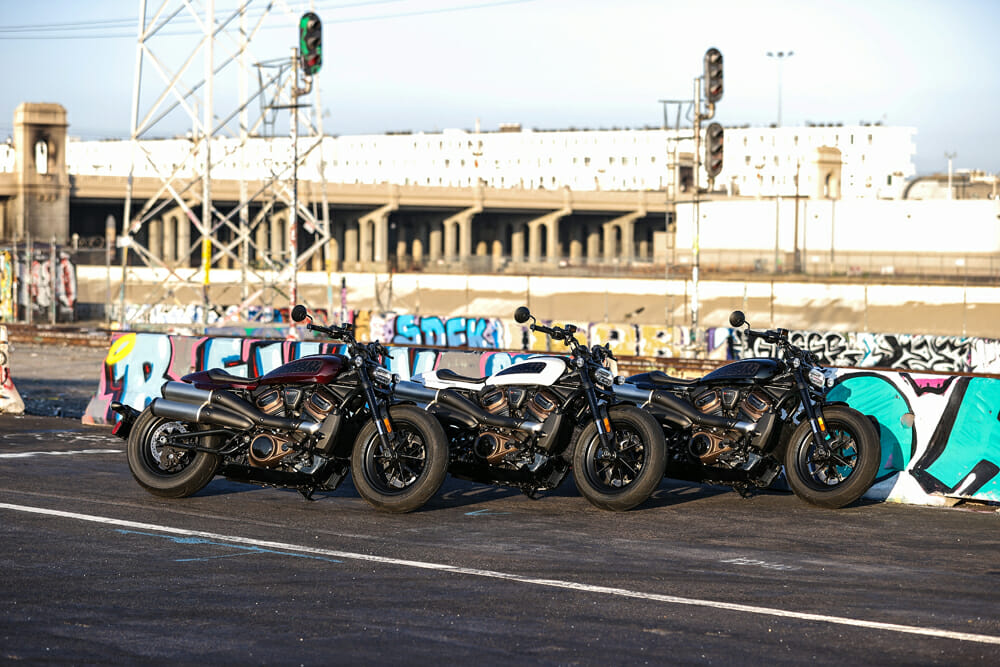 All in the family. You can almost smell the fermented stench of our shooting location through your screen.
All in the family. You can almost smell the fermented stench of our shooting location through your screen.
The $14,999 MSRP 2021 Sportster S ($350 more if you go for the Stone Washed White Pearl of our testbike) is taking the company’s most revered name and turning it on its head, using design styles and methods more reminiscent of sporty red Italian machines than those typically associated with Milwaukee.
Hot on the heels of the so-far roaring success of the Pan America adventure bike (the top-selling ADV bike in the May-June period of this year in America), Kyle Wyman’s victory in the MotoAmerica King of The Baggers series and renewed interest from company executives in the performance possibilities of the most famous name in motorcycling, the Harley-Davidson Motor Company is kicking goals right now.
The Sportster S is the second machine in the new-generation lineup this year that utilizes the Revolution Max 1250T 60° V-twin that debuted in the Pan America earlier this year, re-tuned for stronger torque delivery in the lower half of the rev range. Harley is claiming 121 hp at 7500 rpm (down from 150 hp on the Pan America), with peak torque a thumping 94 foot-pounds at 6000 rpm.
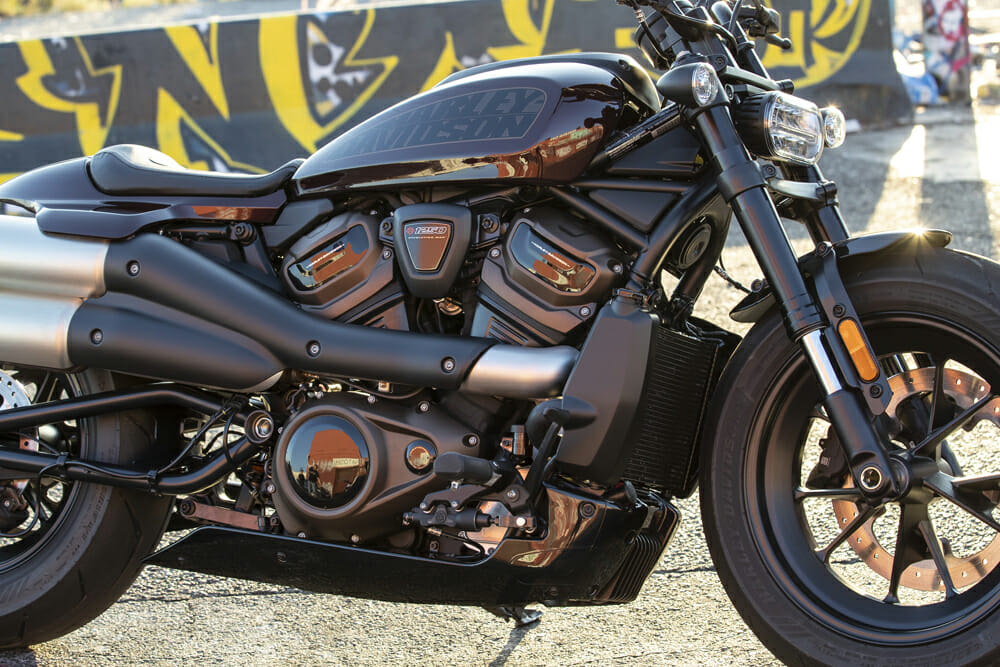 The Revolution Max 1250T motor is a gem of a thing. Harley’s done real good with this one.
The Revolution Max 1250T motor is a gem of a thing. Harley’s done real good with this one.
There’s been subtle changes to the motor including smaller intake and exhaust ports and valves, the combustion chamber came in for a work over. This is an engine very un-Harley like. Double overhead cams, variable valve timing, 30° crankpin offsets, dual counter balancers, throttle bodies and spark plugs, liquid cooling, hydraulic self-adjusting lifters… and the proof is in the ride.
In short, the Sportster S absolutely hammers. I’ll stick my hand up and admit my previous Sportster experience is limited, but I’ve ridden plenty of Harley motors in standard form and none (aside from the immediate rush of torque the electric LiveWire gives you) have as much punch as the Sportster.
Initial throttle response, if you’re used to traditional Harley-Davidsons, feels almost Japanese in its precision. The clunky early throttle openings that almost became a Harley trademark in the past is now firmly in the rear view, and the way the variable-valve-timing system smoothly shifts the motor’s behavior from low to high rpm is impressive. The system adjusts valve timing independently for each exhaust and intake pair of valves, meaning cylinders one and two are treated separately as are intake and exhaust circuits. Depending on ride-mode selection or other settings, the bike will adjust power delivery via valve timing.
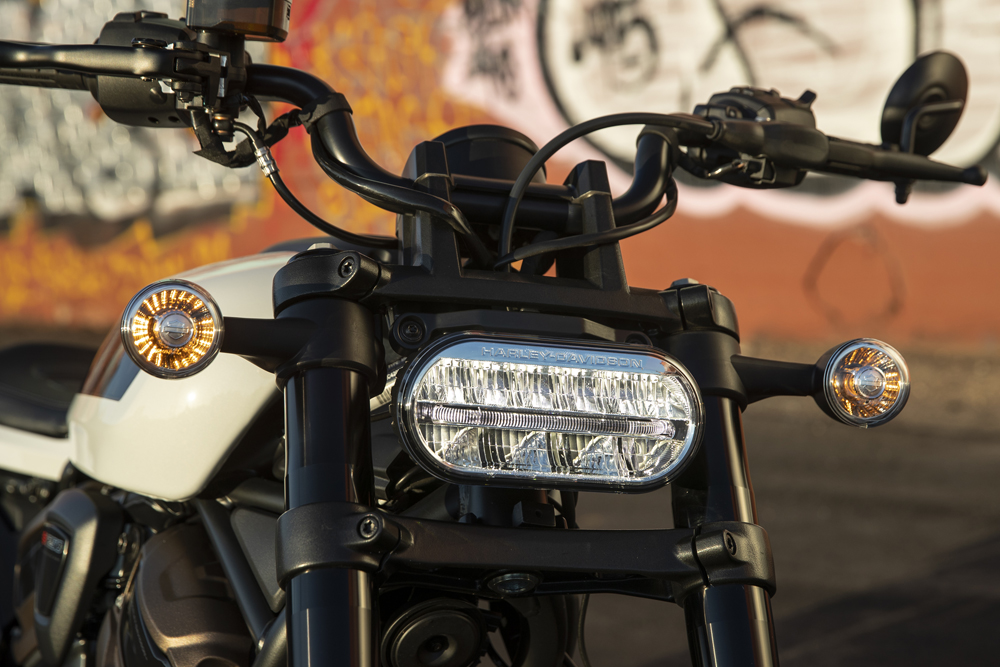 Sunken headlight between the forks is reminiscent of the Fat Bob lineup.
Sunken headlight between the forks is reminiscent of the Fat Bob lineup.
You don’t go hunting revs on the Sportster. It’s best to keep them below 5000 and play with the torque, allowing the motor to use the most of the tall gearing in first and second to get the best performance.
Due to the forward-mount controls, the gearshift is not the as precise as I’d have liked when the shift lever is in the standard position. It’s very high with lots of fore/aft play so unless you’ve got big feet (like, above size 12), you’ll find neutral an annoying number of times when cruising at low speed and shifting from first to second, although moving the shift lever down will largely fix this. Bring your tools because it’s not a fast job to do this.
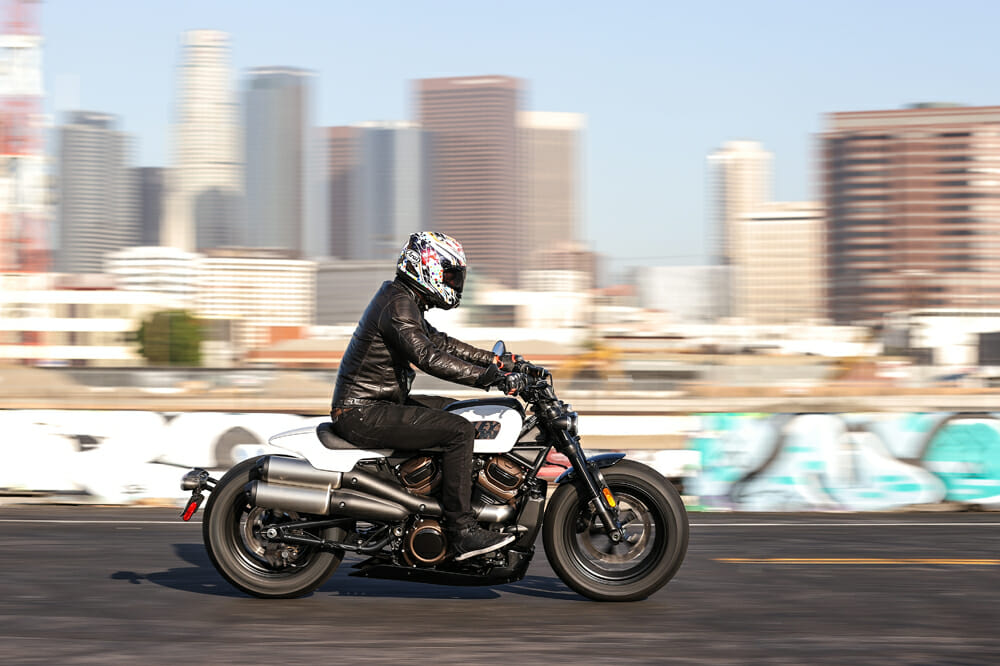 Forward feet controls are nice but Rennie preferred the mid-mounts like a traditional nakedbike.
Forward feet controls are nice but Rennie preferred the mid-mounts like a traditional nakedbike.
The gearbox itself is a remarkable improvement over Harley’s past. It’s much smoother, lighter and more precise than any Harley I’ve every ridden and you won’t get that massive ‘clunk!’ when selecting first gear anymore. It’s a bummer Harley doesn’t offer a quickshifter with this bike, a small thing that would really push it into the ‘now’ and differentiate it further from the last 64 years of Sportster history.
Taking hints from its flat-track program, Harley has fitted the Sportster with two massive exhaust pipes that exit out the right side. Considering their size, they are extremely quiet, but they’re also very hot. The catalytic converter sits just below the rear cylinder head, and, unless you’ve got plenty of airflow happening, you’ll find yourself roasting your inner thigh to a nice medium rare pretty quickly (something to be aware of when riding in the city with lots of stop/starts). Get the Sportster hammering through the twisties and you’ll hardly notice the heat.
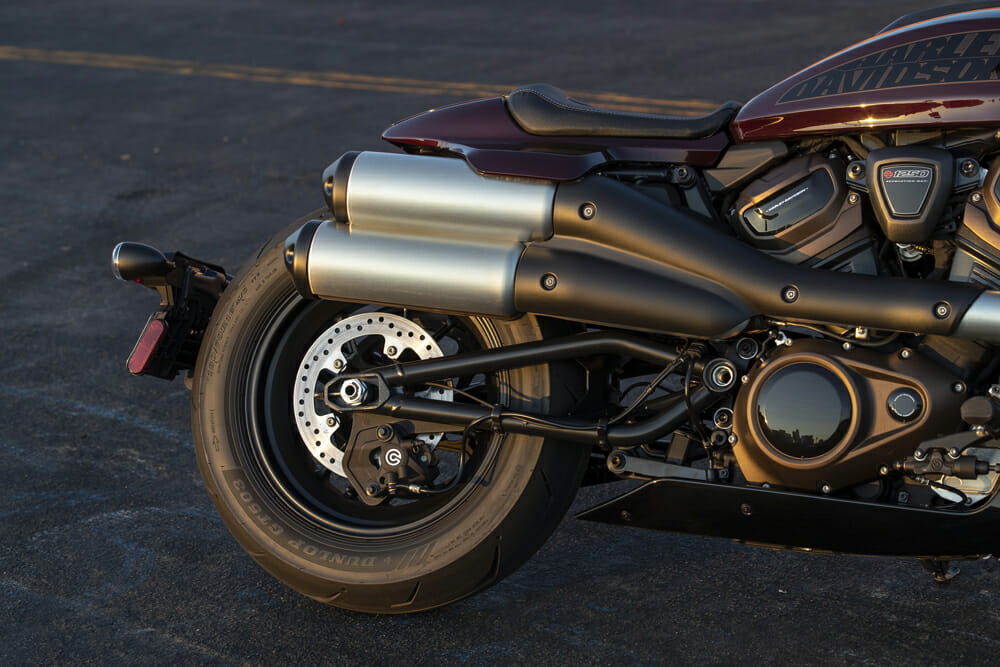 The pipe. A talking point. It looks great, but the heat coming from the combination of it and the rear cylinder heat is obnoxious on warm California days.
The pipe. A talking point. It looks great, but the heat coming from the combination of it and the rear cylinder heat is obnoxious on warm California days.
This is 2021, and, as you’d expect, Harley has given you three preset and one programable ride modes to tailor the throttle response, traction control, engine braking and ABS intervention how you like. Flicking through the modes had me settle on Sport mode, offering the closest one-to-one connection between throttle and rear wheel.
As Harley was very keen to point out at the Sportster intro, the Revolution Max motor is a modular one and thus is used as a stressed member in an all-new chassis designed to substantially increase stiffness for better handling and cornering prowess. The best bike I can compare it to is the XL 1200X Forty-Eight, a machine the new Sportster S takes plenty of design cues from, including the feet-forward ride position and overall dimensions. But the Sportster is a far more modern design with fully adjustable suspension, 43mm Showa inverted forks, a single linkage shock and chunky tubular steel swingarm that looks nothing like Harleys of the past.
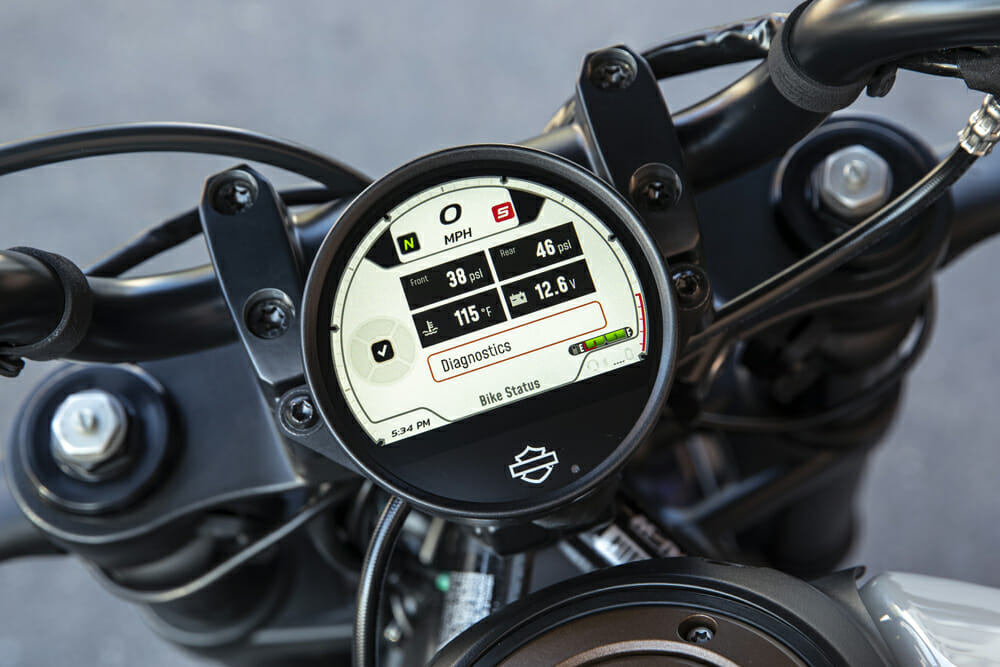 Typical minimalist dash does the job and has a surprisingly large array of features in it.
Typical minimalist dash does the job and has a surprisingly large array of features in it.
Cornering ABS and traction-control systems work well, although ABS kicks in too early for my liking even on the least intrusive setting. The single-disc front brake is fine for around town cruising but lacks overall power and feel at the lever. I get that Harley’s design team wanted a single disc front-end, but I don’t feel a twin-disc setup would have been a disadvantage in terms of looks while still giving a higher level of performance.
You might think it’s all roses and cream at this point, but, like any bike review, there’s got to be a few points of contention. For me, that comes down to the comfort, of lack thereof, regarding the rear suspension.
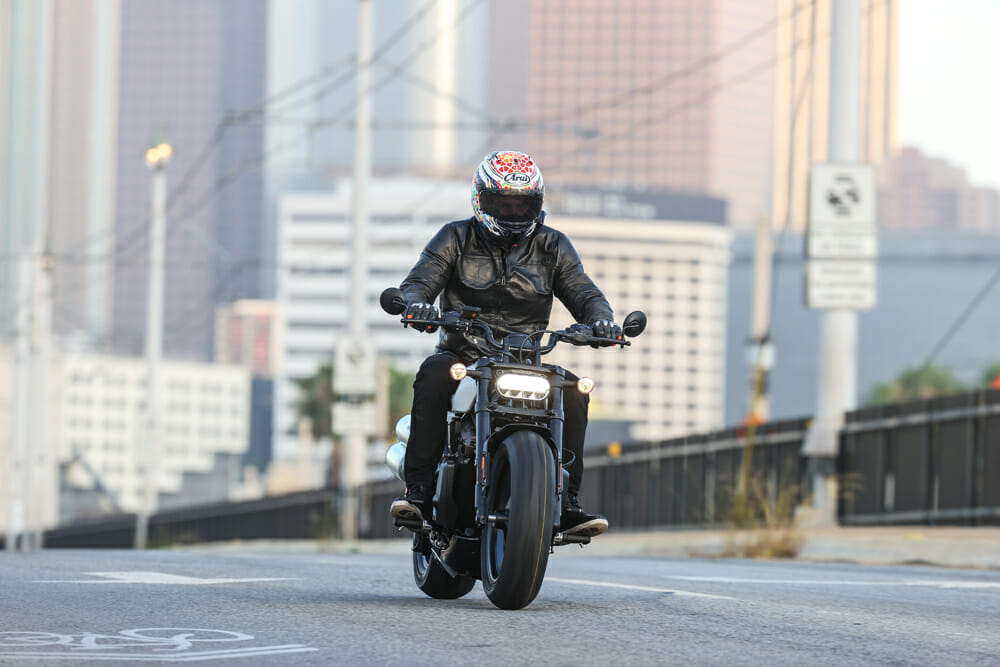 Early morning cruises in DTLA with the Sporty. Take it out of the city for a more enjoyable time.
Early morning cruises in DTLA with the Sporty. Take it out of the city for a more enjoyable time.
You’re sitting 29.6 inches off the ground on the new Sportster S, and you only have a claimed two inches of suspension travel to stop your spine from going through your ass over sharp bumps. In short, it’s far from comfortable over crappy road surfaces. You will feel every one of the road corrugations, with sharp compressions from the high-speed circuit of particular discomfort.
Not helping matters here is the forward-mounted controls, as they’re a bit harder for the rider to lift your ass off the seat when the incoming pothole is spotted. Cue wincing.
You get an extra 1.6 inches of travel from the front suspension, and the difference in ride quality front to back is quite acute.
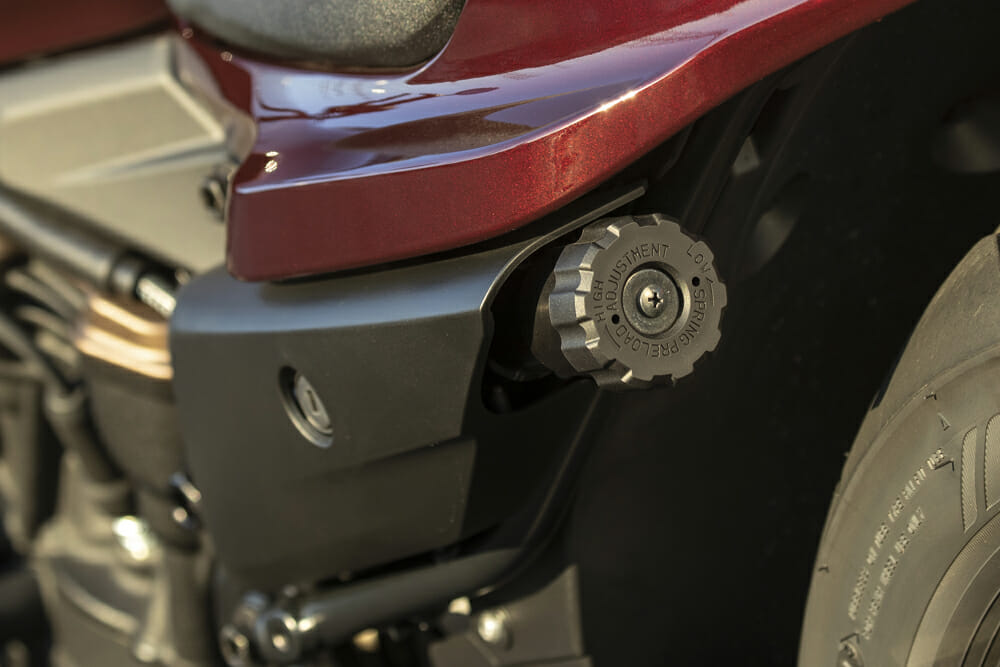 Hand knob for preload adjustment is a welcome feature.
Hand knob for preload adjustment is a welcome feature.
The front, graced with that monstrous Dunlop 160/70 R16 tire, handles the rough stuff far better than you’d think when you glance at it. Once you take into account the claimed 34 degrees of lean angle, you can hustle the Sportster along nicely, although get jiggy with it and you’ll be touching down the footpeg hero knobs real quick.
Later in the test, I was given the chance to ride the Sportster with mid-mounted controls that bring the rider footpeg and controls back a couple of inches. Harley says the mid-mounted controls are more for people who have issues with reaching the forward-mount controls but I don’t have that problem at 6’1”. The mid-mounts made it far easier for me to alleviate weight on my lower back over rough roads, although the ride position was a little more cramped. If my money were going down on a Sportster S, those would be the controls I’d opt for.
Electronics-wise you get everything you’d expect for this price point and a little more. Cruise control (yay!), the four ride modes, turn-by-turn navigation with the Harley app and Bluetooth connectivity are all included in the $15k sticker. The circular four-inch dash is minimalist, but easy enough to navigate once you figure out where everything is and operates.
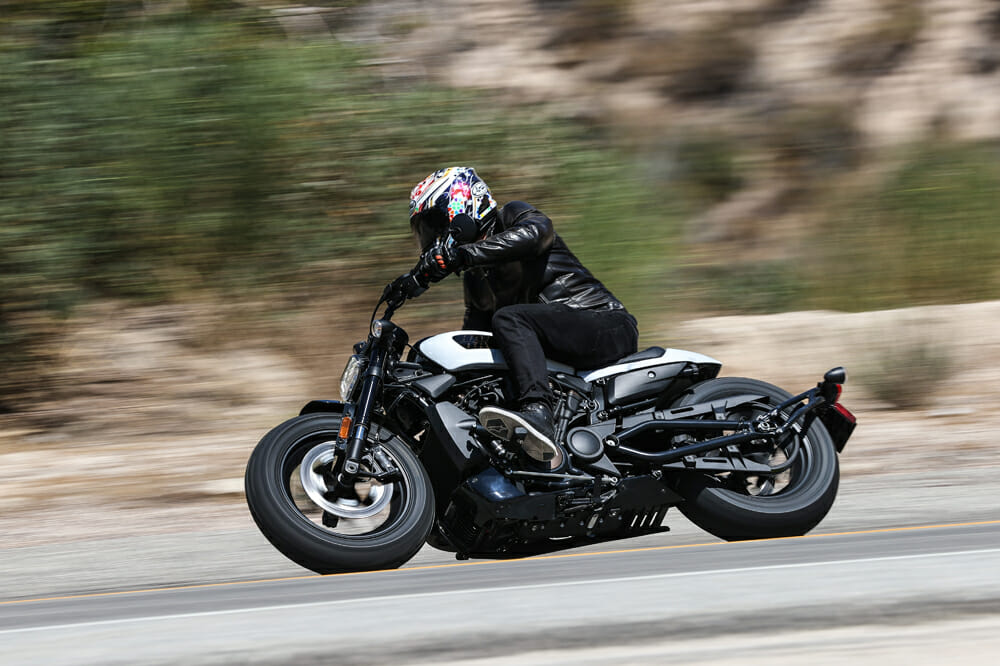 Canyon carving is where the Sporty shines. It’s a great little steed to hustle up the side of a mountain.
Canyon carving is where the Sporty shines. It’s a great little steed to hustle up the side of a mountain.
Harley has developed a range of accessories for Sportster S designed mainly for touring purposes (with a few bling bits like cam and clutch covers), which is odd, because this is the last bike I’d take touring due to that rear suspension comfort.
Herein lies the problem with the Sportster S. It’s a pretty one-dimensional motorcycle, which is fine if you’re after this particular style of ride. Harley wants to inject the sport back in Sportster, and for that they’ve done a good job. Get the S out in the flowing canyons and the ride is a sweet one. It carves a line smoothly, brakes adequately and is then met with that sensational Revolution Max motor on corner exit. But don’t go buying a Sportster thinking you’ll get anything like the versatility when compared to something like a nakedbike.
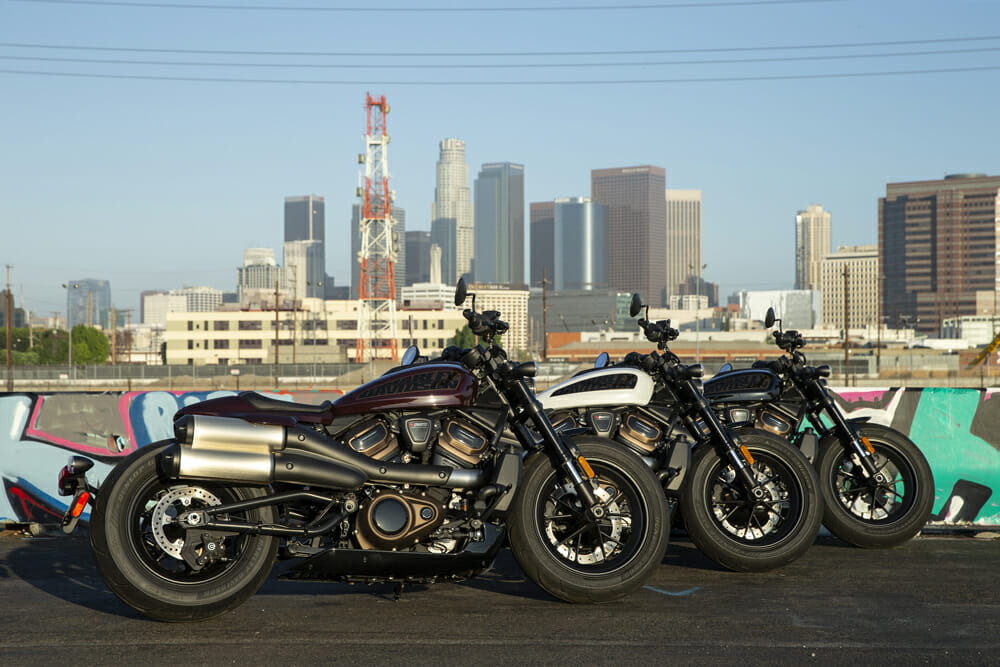
This brings me to the final point. For me, the Sportster is exciting not for what it is now, but where it will take Harley-Davidson. My sincere hope is Harley-Davidson does go ahead and create the Bronx (it’s not canned as many think, just put on ice for now) using this motor and chassis architecture, because they have a golden opportunity to fill a spot in the market left vacant by Triumph’s insistence on playing with the big boys and their new Speed Triple, which used to be a street bruiser but is now basically a superbike without the fairing.
The Sportster is not my cup of motorcycling tea, but that’s not to say it’s not a good motorcycle. Taking the style of the bike into account and who it is targeted at, those riders will find a good time in the Sportster. This is certainly a different take on the Sportster legend, which, after all, is exactly what the designers were hoping for.CN
VIDEO | 2021 Harley-Davidson Sportster S Review
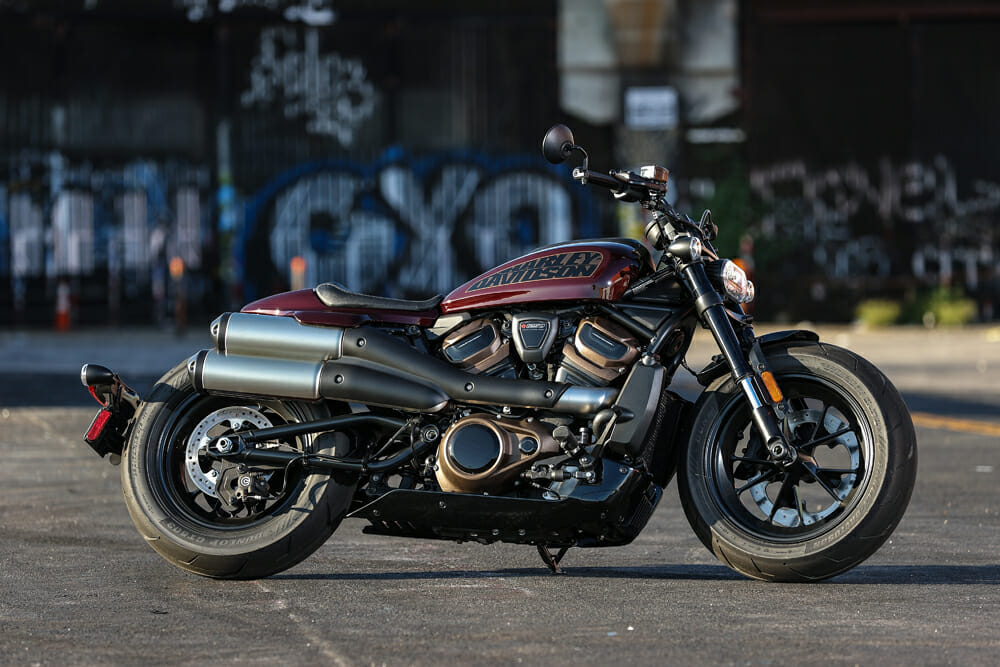
2021 Harley-Davidson Sportster S Specifications
| Engine: |
Revolution Max 1250, VVT, four-stroke |
| Valvetrain: |
Chain-driven, DOHC, 8-valve |
| Displacement: |
1252cc |
| Bore x stroke: |
105 x 72mm |
| Fuel injection: |
Electronic Sequential Port Fuel Injection (ESPFI) |
| Compression ratio: |
13.0:1 |
| Power (claimed): |
121 hp at 7500 rpm) |
| Torque (claimed): |
94 lb-ft at 6000 rpm |
| Exhaust: |
2-into-2 |
| Transmission: |
6-speed |
| Clutch: |
Wet, multi-plate, assist and slip |
| Chassis: |
Stressed member, alloy steel trellis frame |
| Front suspension: |
43mm Showa fork, fully adjustable |
| Rear suspension: |
Linkage-mounted monoshock, fully adjustable |
| Front brake: |
Single 320mm radially mounted Brembo monobloc 4-piston caliper, Cornering ABS |
| Rear brake: |
260mm disc, 2-piston caliper, Cornering ABS |
| Front tire: |
160/70TR17 73V |
| Rear tire: |
180/70R16 77V |
| Wheelbase: |
59.8 in. |
| Seat height: |
29.6 in. |
| Fuel capacity: |
3.1 gal. |
| Weight (curb, claimed): |
486 lbs. |
| Colors: |
Stone Washed White Pearl, Midnight Crimson, Vivid Black |
